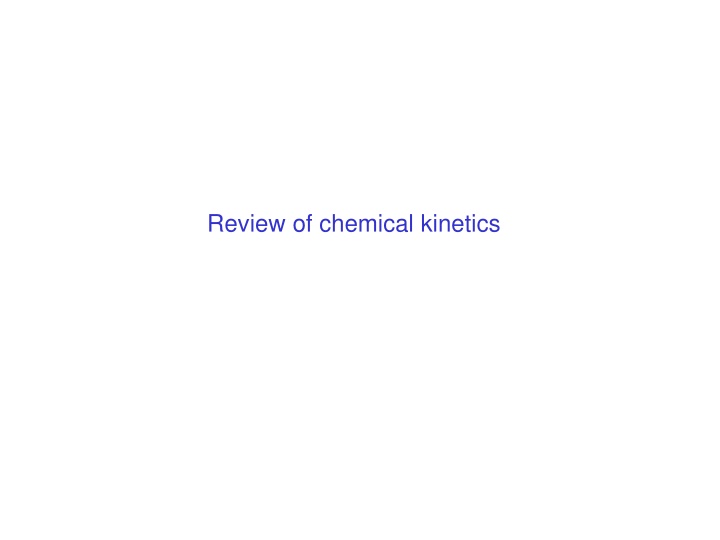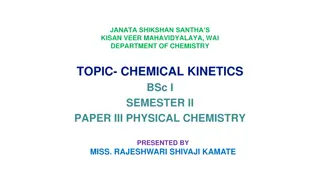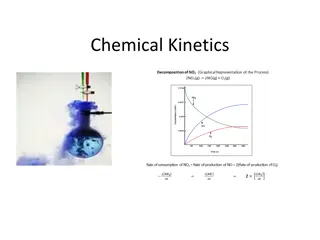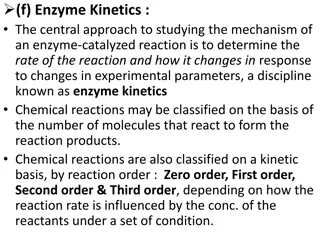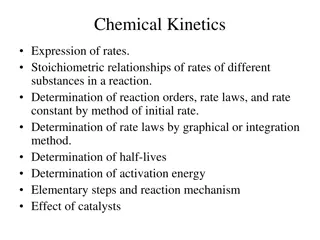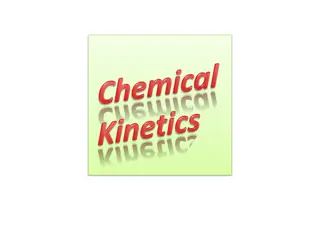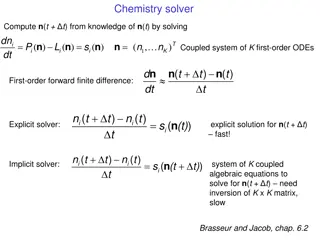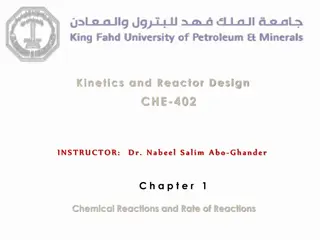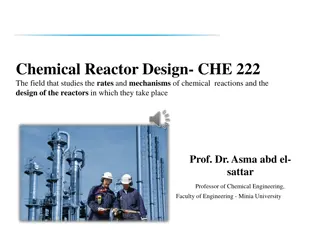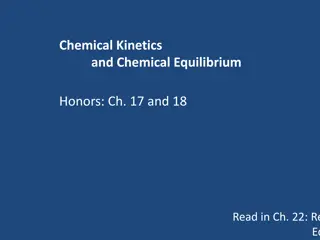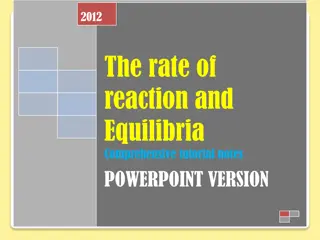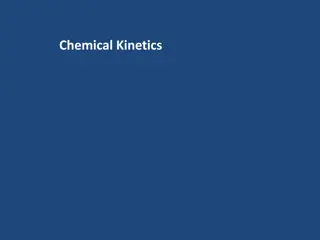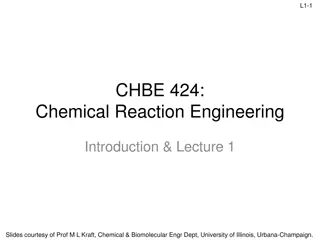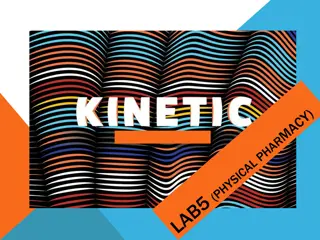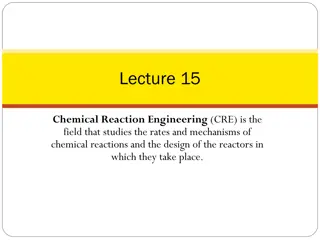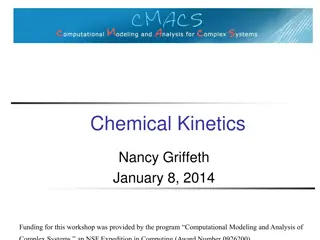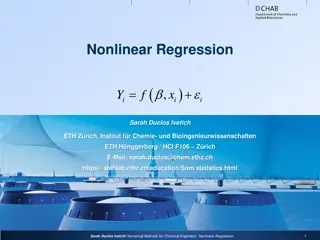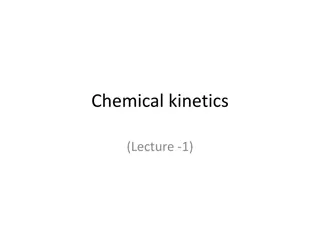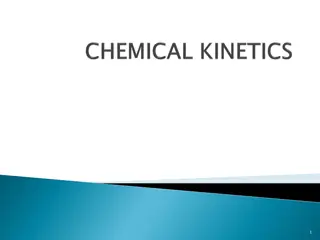Chemical Kinetics Essentials
Understanding chemical kinetics is crucial in studying reaction rates, mechanisms, and pathways. Explore bimolecular reactions, three-body reactions, thermolysis, photolysis, and more. Discover key concepts like rate constants, Arrhenius expressions, and quantum yields.
Download Presentation

Please find below an Image/Link to download the presentation.
The content on the website is provided AS IS for your information and personal use only. It may not be sold, licensed, or shared on other websites without obtaining consent from the author.If you encounter any issues during the download, it is possible that the publisher has removed the file from their server.
You are allowed to download the files provided on this website for personal or commercial use, subject to the condition that they are used lawfully. All files are the property of their respective owners.
The content on the website is provided AS IS for your information and personal use only. It may not be sold, licensed, or shared on other websites without obtaining consent from the author.
E N D
Presentation Transcript
Bimolecular reaction A + B [A] [A][B] k dt C + D d In gas phase, [A] is in [molecules cm-3] = Rate: k is rate constant [cm3 molecule-1 s-1] Ea = ( ) k T exp[ / ] A E RT a Arrhenius expression Reaction is exothermic if heat is released: likely to occur, but may be slow if Eais large Reaction is endothermic if heat is absorbed: can be safely neglected
Three-body reaction: single product from two reactants k A + B AB* 1 Mechanism: k + M is a third body, generally N2 or O2; [M] is air density 1 k AB* + M M* Net: A + B + M AB + M* 2 M heat AB + M [A][B][M] [M] k + [AB] dt 1 2 k k k d = = From steady state for AB*, general solution: [AB*][M] k 2 1 2 ko [AB] dt 1 2 k k k d = = [A][B][M] [A][B][M] k Low-pressure limit: o 1 [AB] dt d = = [A][B] k [A][B] k k High-pressure limit: 1 [ ] k M [AB] dt d = o k M k = [A][B] k with General formulation: [ k ] + 1 o
Thermolysis: reverse of 3-body reaction Net: AB + M A + B + M k AB +M AB* + M 1 Mechanism: k 1 k AB* A+B 2 From steady state for AB*, general solution: [AB][M] [M] + [M] + [B] dt 2 1 k k k k k d = = = = [AB*] [AB] with k k k 1 2 [M] 2 k k k 1 2 1 2 = 1[M] k k k k ok Low-pressure limit: = k 1 2 High-pressure limit: 1
Photolysis [A] dt d + = A B + C [A] h k k [s-1] is the photolysis rate constant (also called photolysis frequency) wavelength [cm] = ( ) ( ) k q I d A A radiation flux: vertical 0 actinic flux [photons cm-2 s-1] actinic flux: all directions absorption cross-section [cm2 molecule-1] Absorption cross-section photon is not absorbed quantum yield: probability that photon absorption causes photolysis photon is absorbed Molecular cross-section A Probability of absorption for incoming photons = /A
Example of photolysis reaction: O3 + hv O2 + O(1D) excited state = ( ) ( ) k O(1D) q I d O3 0 solar flux I at sea level ozone absorption cross-section q I Photolysis at sea level is controlled by photons in 300-320 nm range O(1D) quantum yield q
Chemical radicals Chemical radicals are atoms or molecules with unpaired electrons Do not confuse with hydroxide ion OH-, which is not a radical Example: hydroxyl radical (OH) The unpaired electron makes radicals highly reactive, with atmospheric lifetimes of generally less than a minute. One can reliably assume chemical steady state for radicals (chemical production = chemical loss) To determine whether a species is a radical, add up the electrons contributed by each atom of the molecule. If the total number is odd, then the species is a radical; if it is even then the species is a non-radical. Very exceptionally, a species with an even number of electrons may be a biradical and hence very reactive, or in a singlet state and even more reactive. O(3P) and O(1D) are the only such cases that we will encounter.
Radical-assisted reaction chains Initiation: non-radical + energy radical + radical Propagation: radical + non-radical non-radical + radical X Termination: radical + radical radical + radical + M non-radical + non-radical non-radical propagation rate chain length = termination rate Radical family can generally be assumed to be in steady state: = [radical( )] i ~ minutes i initiation rate = termination rate radical family termination rate [X] dt d = chain length initiation rate Catalytic destruction of non-radical species X:
